A Case Study of Ozone Pollution in a Typical Yangtze River Delta City During Typhoon: Identifying Precursors, Assessing Health Risks, and Informing Local Governance
Abstract
1. Introduction
2. Date and Methods
2.1. Observed Meteorological and Chemical Data
2.2. Usage Mode and Method
2.2.1. CMAQ ISAM Model
2.2.2. Positive Matrix Factorization Model
2.2.3. Health Risk Assessment
2.2.4. Calculation of LOH and OFP
3. Results and Discussion
3.1. Pollution Profile and Meteorological Characteristics
3.2. Model Simulation Verification and Regional Contribution of Ozone During Typhoon
3.3. Identification of Key VOCs in Ozone Formation
3.4. Analysis of the Source of Ozone Precursor (VOCs) During Typhoon
3.5. Ozone Precursor (VOCs) NCR Health Risk Assessment and LCR Health Risk Assessment During Typhoon
3.6. Control Strategies for Ozone Pollution Episodes During Typhoon
4. Conclusions
Supplementary Materials
Author Contributions
Funding
Informed Consent Statement
Data Availability Statement
Acknowledgments
Conflicts of Interest
References
- Staehelin, J.; Harris, N.R.P.; Appenzeller, C.; Eberhard, J. Ozone trends: A review. Rev. Geophys. 2001, 39, 231–290. [Google Scholar] [CrossRef]
- Bernhard, G.H.; Bais, A.F.; Aucamp, P.J.; Klekociuk, A.R.; Liley, J.B.; McKenzie, R.L. Stratospheric ozone, UV radiation, and climate interactions. Photochem. Photobiol. Sci. 2023, 22, 937–989. [Google Scholar] [CrossRef]
- Wilson, S.R.; Madronich, S.; Longstreth, J.D.; Solomon, K.R. Interactive effects of changing stratospheric ozone and climate on tropospheric composition and air quality, and the consequences for human and ecosystem health. Photochem. Photobiol. Sci. 2019, 18, 775–803. [Google Scholar] [CrossRef]
- Seinfeld, J.H.; Pandis, S.N. Atmospheric Chemistry and Physics: From Air Pollution to Climate Change; John Wiley & Sons: Hoboken, NJ, USA, 2016. [Google Scholar]
- Fowler, D.; Amann, M.; Anderson, R.; Ashmore, M.; Cox, P.; Depledge, M.; Derwent, D.; Grennfelt, P.; Hewitt, N.; Hov, O. Ground-Level Ozone in the 21st Century: Future Trends, Impacts and Policy Implications; The Royal Society: London, UK, 2008. [Google Scholar]
- Monks, P.S.; Archibald, A.T.; Colette, A.; Cooper, O.; Coyle, M.; Derwent, R.; Fowler, D.; Granier, C.; Law, K.S.; Mills, G.E.; et al. Tropospheric ozone and its precursors from the urban to the global scale from air quality to short-lived climate forcer. Atmos. Chem. Phys. 2015, 15, 8889–8973. [Google Scholar] [CrossRef]
- Ma, T.; Duan, F.K.; He, K.B.; Qin, Y.; Tong, D.; Geng, G.N.; Liu, X.Y.; Li, H.; Yang, S.; Ye, S.Q.; et al. Air pollution characteristics and their relationship with emissions and meteorology in the Yangtze River Delta region during 2014-2016. J. Environ. Sci. 2019, 83, 8–20. [Google Scholar] [CrossRef] [PubMed]
- Zhang, X.; Ma, Q.; Chu, W.; Ning, M.; Liu, X.; Xiao, F.; Cai, N.; Wu, Z.; Yan, G. Identify the key emission sources for mitigating ozone pollution: A case study of urban area in the Yangtze River Delta region, China. Sci. Total Environ. 2023, 892, 164703. [Google Scholar] [CrossRef]
- Hu, F.; Xie, P.; Zhu, Y.; Zhang, F.; Xu, J.; Lv, Y.; Zhang, Z.; Zheng, J.; Zhang, Q.; Li, Y. The impact of evolving synoptic weather patterns on multi-scale transport and sources of persistent high-concentration ozone pollution event in the Yangtze River Delta, China. Sci. Total Environ. 2024, 949, 175048. [Google Scholar] [CrossRef]
- Xie, M.; Liao, J.B.; Wang, T.J.; Zhu, K.G.; Zhuang, B.L.; Han, Y.; Li, M.M.; Li, S. Modeling of the anthropogenic heat flux and its effect on regional meteorology and air quality over the Yangtze River Delta region, China. Atmos. Chem. Phys. 2016, 16, 6071–6089. [Google Scholar] [CrossRef]
- Qi, C.; Wang, P.; Yang, Y.; Li, H.; Zhang, H.; Ren, L.; Jin, X.; Zhan, C.; Tang, J.; Liao, H. Impacts of tropical cyclone–heat wave compound events on surface ozone in eastern China: Comparison between the Yangtze River and Pearl River deltas. Atmos. Chem. Phys. 2024, 24, 11775–11789. [Google Scholar] [CrossRef]
- Zhan, C.; Xie, M.; Huang, C.; Liu, J.; Wang, T.; Xu, M.; Ma, C.; Yu, J.; Jiao, Y.; Li, M.; et al. Ozone affected by a succession of four landfall typhoons in the Yangtze River Delta, China: Major processes and health impacts. Atmos. Chem. Phys. 2020, 20, 13781–13799. [Google Scholar] [CrossRef]
- Chen, Z.; Liu, J.; Cheng, X.; Yang, M.; Wang, H. Positive and negative influences of typhoons on tropospheric ozone over southern China. Atmos. Chem. Phys. 2021, 21, 16911–16923. [Google Scholar] [CrossRef]
- Meng, K.; Zhao, T.; Xu, X.; Hu, Y.; Zhao, Y.; Zhang, L.; Pang, Y.; Ma, X.; Bai, Y.; Zhao, Y.; et al. Anomalous surface O3 changes in North China Plain during the northwestward movement of a landing typhoon. Sci. Total Environ. 2022, 820, 153196. [Google Scholar] [CrossRef]
- Wang, M.; Ma, J.; Tao, C.; Gao, Y.; Zhang, R.; Wang, P.; Zhang, H. Regional source contributions to summertime ozone in the Yangtze River Delta. Atmos. Environ. 2024, 338, 120822. [Google Scholar] [CrossRef]
- Wang, W.; Fang, H.; Zhang, Y.; Ding, Y.; Hua, F.; Wu, T.; Yan, Y. Characterizing sources and ozone formations of summertime volatile organic compounds observed in a medium-sized city in Yangtze River Delta region. Chemosphere 2023, 328, 138609. [Google Scholar] [CrossRef]
- He, L.; Duan, Y.; Zhang, Y.; Yu, Q.; Huo, J.; Chen, J.; Cui, H.; Li, Y.; Ma, W. Effects of VOC emissions from chemical industrial parks on regional O3-PM2. 5 compound pollution in the Yangtze River Delta. Sci. Total Environ. 2024, 906, 167503. [Google Scholar] [CrossRef] [PubMed]
- Shu, Q.; Napelenok, S.L.; Hutzell, W.T.; Baker, K.R.; Murphy, B.; Hogrefe, C.; Henderson, B.H. Source Attribution of Ozone and Precursors in the Northeast US Using Multiple Photochemical Model Based Approaches (CMAQ v5. 3.2 and CAMx v7. 10). Geosci. Model Dev. Discuss. 2022, 2022, 1–34. [Google Scholar]
- Xian, Y.; Zhang, Y.; Liu, Z.; Wang, H.; Wang, J.; Tang, C. Source apportionment and formation of warm season ozone pollution in Chengdu based on CMAQ-ISAM. Urban Clim. 2024, 56, 102017. [Google Scholar] [CrossRef]
- Li, B.; Ho, S.S.H.; Gong, S.; Ni, J.; Li, H.; Han, L.; Yang, Y.; Qi, Y.; Zhao, D. Characterization of VOCs and their related atmospheric processes in a central Chinese city during severe ozone pollution periods. Atmos. Chem. Phys. 2019, 19, 617–638. [Google Scholar] [CrossRef]
- He, Z.; Wang, X.; Ling, Z.; Zhao, J.; Guo, H.; Shao, M.; Wang, Z. Contributions of different anthropogenic volatile organic compound sources to ozone formation at a receptor site in the Pearl River Delta region and its policy implications. Atmos. Chem. Phys. 2019, 19, 8801–8816. [Google Scholar] [CrossRef]
- Yuan, B.; Shao, M.; De Gouw, J.; Parrish, D.D.; Lu, S.; Wang, M.; Zeng, L.; Zhang, Q.; Song, Y.; Zhang, J. Volatile organic compounds (VOCs) in urban air: How chemistry affects the interpretation of positive matrix factorization (PMF) analysis. J. Geophys. Res. Atmos. 2012, 117. [Google Scholar] [CrossRef]
- Wu, Y.; Liu, B.; Meng, H.; Dai, Q.; Shi, L.; Song, S.; Feng, Y.; Hopke, P.K. Changes in source apportioned VOCs during high O3 periods using initial VOC-concentration-dispersion normalized PMF. Sci. Total Environ. 2023, 896, 165182. [Google Scholar] [CrossRef] [PubMed]
- Su, Y.-C.; Chen, W.-H.; Fan, C.-L.; Tong, Y.-H.; Weng, T.-H.; Chen, S.-P.; Kuo, C.-P.; Wang, J.-L.; Chang, J.S. Source apportionment of volatile organic compounds (VOCs) by positive matrix factorization (PMF) supported by model simulation and source markers-using petrochemical emissions as a showcase. Environ. Pollut. 2019, 254, 112848. [Google Scholar] [CrossRef]
- Paatero, P. Least squares formulation of robust non-negative factor analysis. Chemom. Intell. Lab. Syst. 1997, 37, 23–35. [Google Scholar] [CrossRef]
- Pál, L.; Lovas, S.; McKee, M.; Diószegi, J.; Kovács, N.; Szűcs, S. Exposure to volatile organic compounds in offices and in residential and educational buildings in the European Union between 2010 and 2023: A systematic review and health risk assessment. Sci. Total Environ. 2024, 945, 173965. [Google Scholar] [CrossRef]
- Nayek, S.; Padhy, P.K. Personal exposure to VOCs (BTX) and women health risk assessment in rural kitchen from solid biofuel burning during cooking in West Bengal, India. Chemosphere 2020, 244, 125447. [Google Scholar] [CrossRef] [PubMed]
- Xiong, Y.; Bari, M.A.; Xing, Z.; Du, K. Ambient volatile organic compounds (VOCs) in two coastal cities in western Canada: Spatiotemporal variation, source apportionment, and health risk assessment. Sci. Total Environ. 2020, 706, 135970. [Google Scholar] [CrossRef]
- Zheng, H.; Kong, S.; Chen, N.; Niu, Z.; Zhang, Y.; Jiang, S.; Yan, Y.; Qi, S. Source apportionment of volatile organic compounds: Implications to reactivity, ozone formation, and secondary organic aerosol potential. Atmos. Res. 2021, 249, 105344. [Google Scholar] [CrossRef]
- Abeleira, A.; Pollack, I.B.; Sive, B.; Zhou, Y.; Fischer, E.V.; Farmer, D.K. Source characterization of volatile organic compounds in the Colorado Northern Front Range Metropolitan Area during spring and summer 2015. J. Geophys. Res. Atmos. 2017, 122, 3595–3613. [Google Scholar] [CrossRef]
- Atkinson, R.; Arey, J. Atmospheric Degradation of Volatile Organic Compounds. Chem. Rev. 2003, 103, 4605–4638. [Google Scholar] [CrossRef]
- Carter, W.P.L. Development of Ozone Reactivity Scales for Volatile Organic Compounds. Air Waste 2012, 44, 881–899. [Google Scholar] [CrossRef]
- Kumar, A.; Singh, D.; Kumar, K.; Singh, B.B.; Jain, V.K. Distribution of VOCs in urban and rural atmospheres of subtropical India: Temporal variation, source attribution, ratios, OFP and risk assessment. Sci. Total Environ. 2018, 613–614, 492–501. [Google Scholar] [CrossRef] [PubMed]
- Ma, W.; Feng, Z.; Zhan, J.; Liu, Y.; Liu, P.; Liu, C.; Ma, Q.; Yang, K.; Wang, Y.; He, H.; et al. Influence of photochemical loss of volatile organic compounds on understanding ozone formation mechanism. Atmos. Chem. Phys. 2022, 22, 4841–4851. [Google Scholar] [CrossRef]
- Huang, S.; Shao, M.; Lu, S.; Liu, Y. Reactivity of ambient volatile organic compounds (VOCs) in summer of 2004 in Beijing. Chin. Chem. Lett. 2008, 19, 573–576. [Google Scholar] [CrossRef]
- Ahmed, M.; Rappenglück, B.; Das, S.; Chellam, S. Source apportionment of volatile organic compounds, CO, SO2 and trace metals in a complex urban atmosphere. Environ. Adv. 2021, 6, 100127. [Google Scholar] [CrossRef]
- Liu, Z.; Hu, K.; Zhang, K.; Zhu, S.; Wang, M.; Li, L. VOCs sources and roles in O3 formation in the central Yangtze River Delta region of China. Atmos. Environ. 2023, 302, 119755. [Google Scholar] [CrossRef]
- Lv, Z.; Liu, X.; Wang, G.; Shao, X.; Li, Z.; Nie, L.; Li, G. Sector-based volatile organic compounds emission characteristics from the electronics manufacturing industry in China. Atmos. Pollut. Res. 2021, 12, 101097. [Google Scholar] [CrossRef]
- Mo, Z.; Shao, M.; Lu, S.; Qu, H.; Zhou, M.; Sun, J.; Gou, B. Process-specific emission characteristics of volatile organic compounds (VOCs) from petrochemical facilities in the Yangtze River Delta, China. Sci. Total Environ. 2015, 533, 422–431. [Google Scholar] [CrossRef]
- Mo, Z.; Cui, R.; Yuan, B.; Cai, H.; McDonald, B.C.; Li, M.; Zheng, J.; Shao, M. A mass-balance-based emission inventory of non-methane volatile organic compounds (NMVOCs) for solvent use in China. Atmos. Chem. Phys. 2021, 21, 13655–13666. [Google Scholar] [CrossRef]
- Simon, H.; Reff, A.; Wells, B.; Xing, J.; Frank, N. Ozone Trends Across the United States over a Period of Decreasing NOx and VOC Emissions. Environ. Sci. Technol. 2015, 49, 186–195. [Google Scholar] [CrossRef]
- Ling, Z.H.; Guo, H. Contribution of VOC sources to photochemical ozone formation and its control policy implication in Hong Kong. Environ. Sci. Policy 2014, 38, 180–191. [Google Scholar] [CrossRef]
- Li, Y.; Liu, Y.; Hou, M.; Huang, H.; Fan, L.; Ye, D. Characteristics and sources of volatile organic compounds (VOCs) in Xinxiang, China, during the 2021 summer ozone pollution control. Sci. Total Environ. 2022, 842, 156746. [Google Scholar] [CrossRef] [PubMed]
- Liu, Y.; Qiu, P.; Xu, K.; Li, C.; Yin, S.; Zhang, Y.; Ding, Y.; Zhang, C.; Wang, Z.; Zhai, R.; et al. Analysis of VOC emissions and O3 control strategies in the Fenhe Plain cities, China. J. Environ. Manag. 2023, 325, 116534. [Google Scholar] [CrossRef] [PubMed]

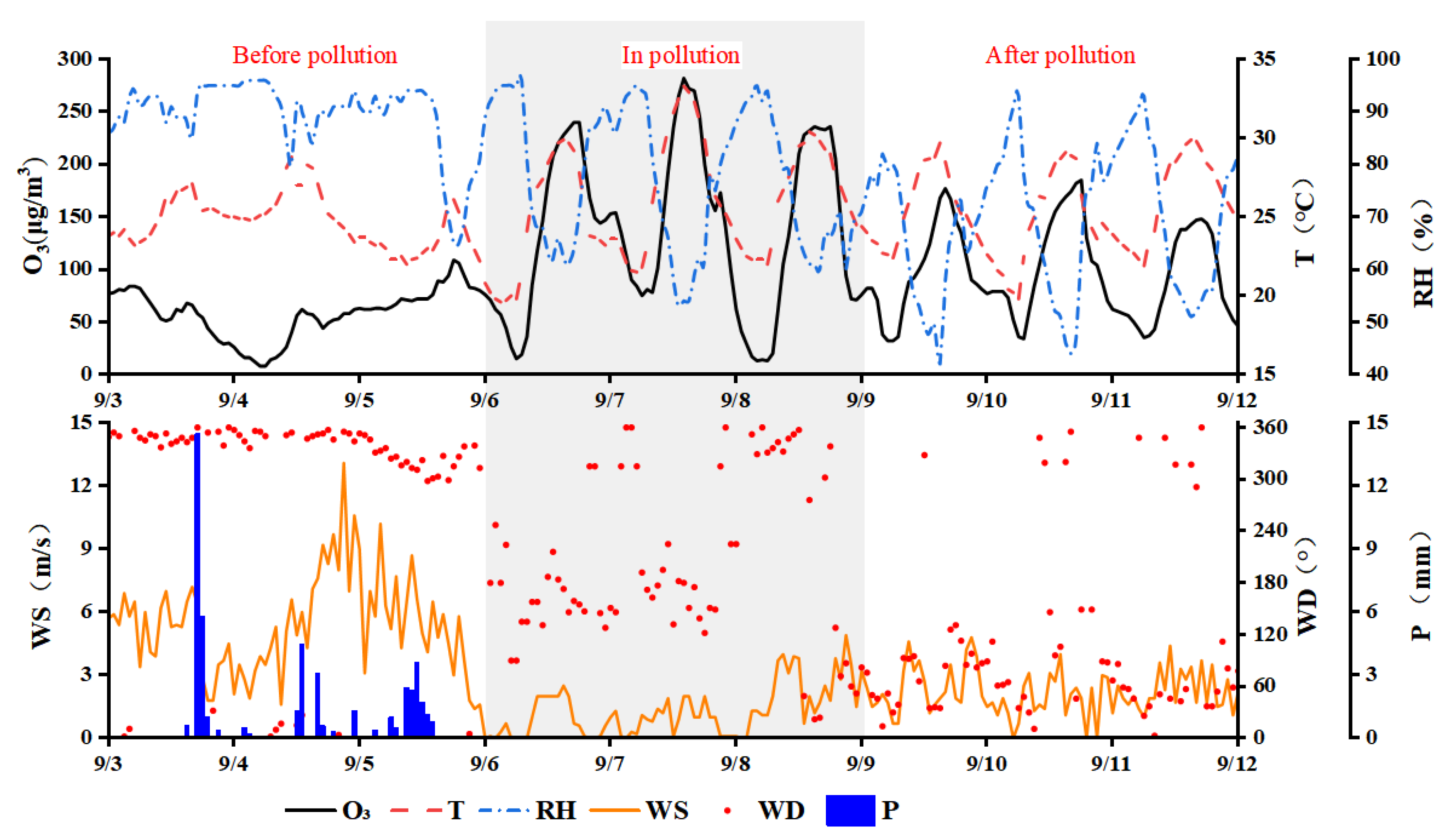
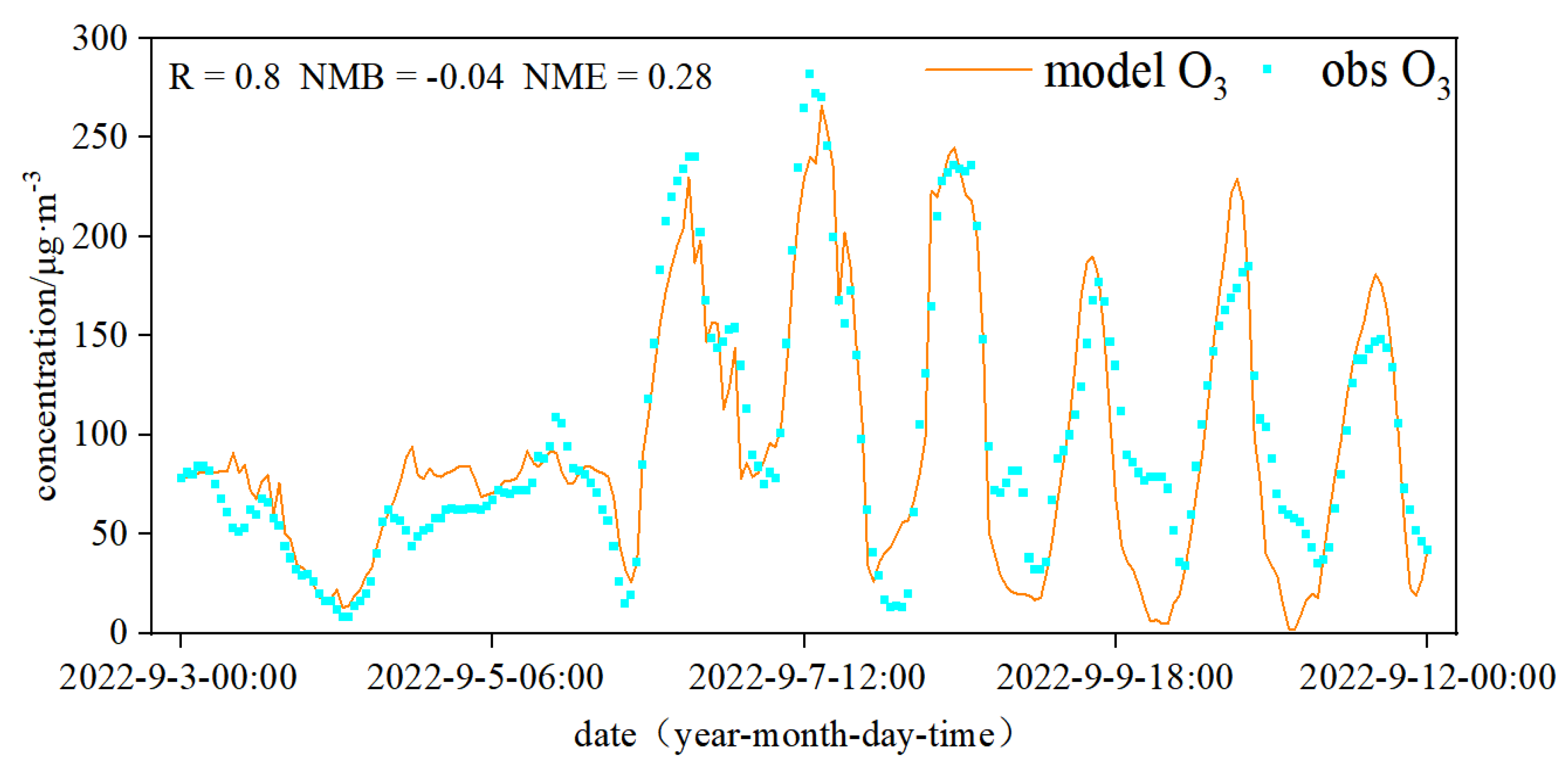
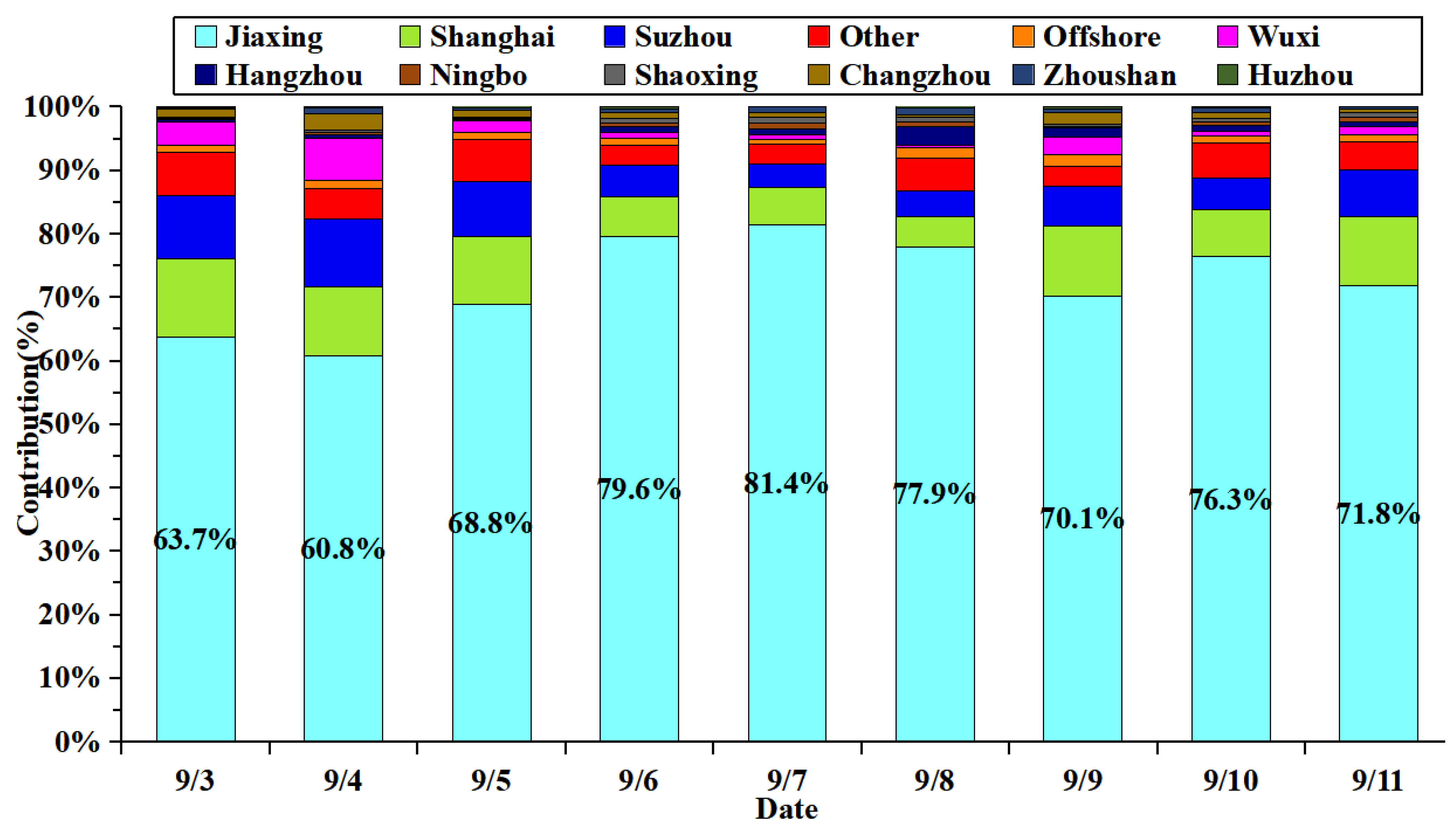

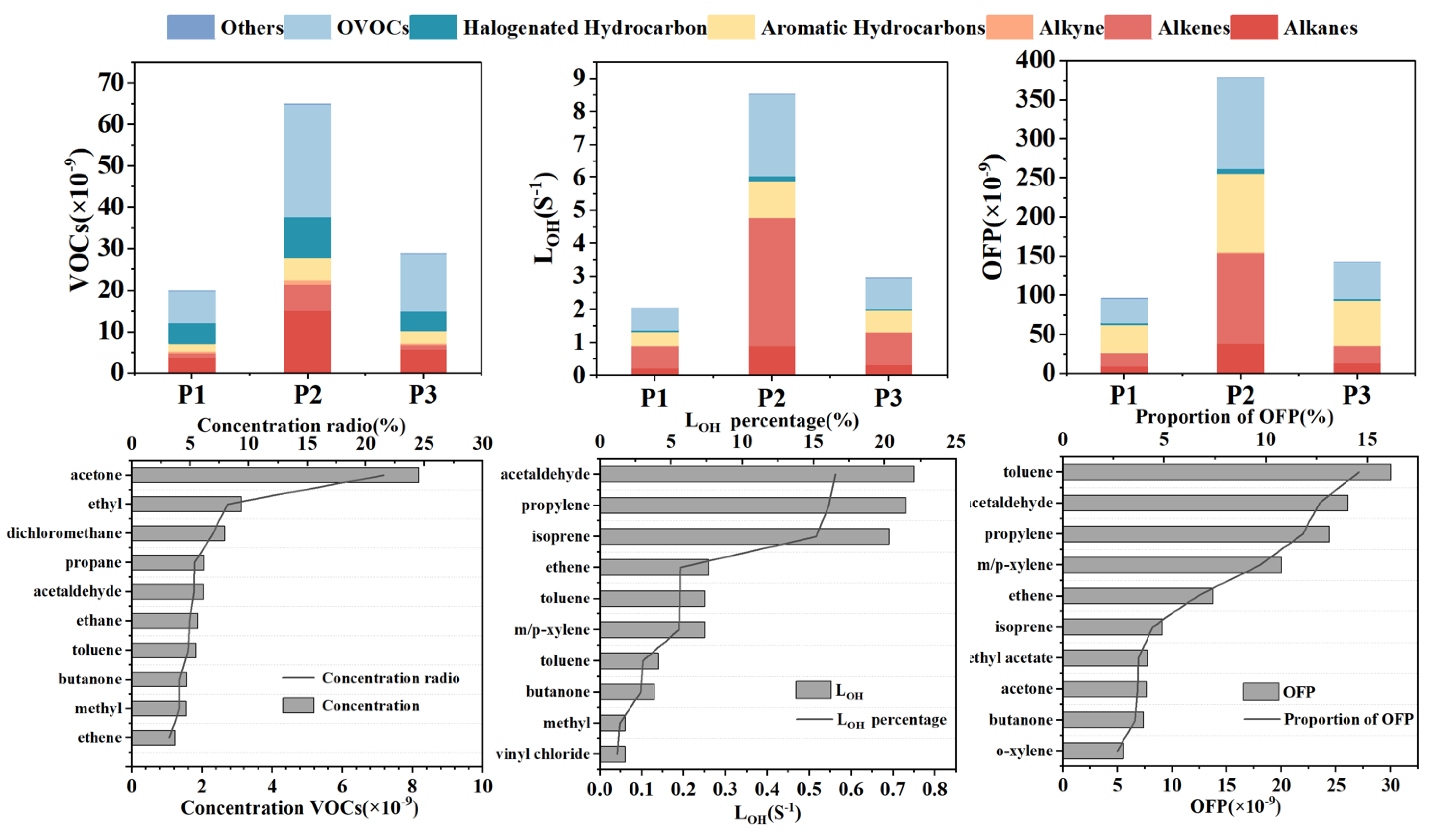
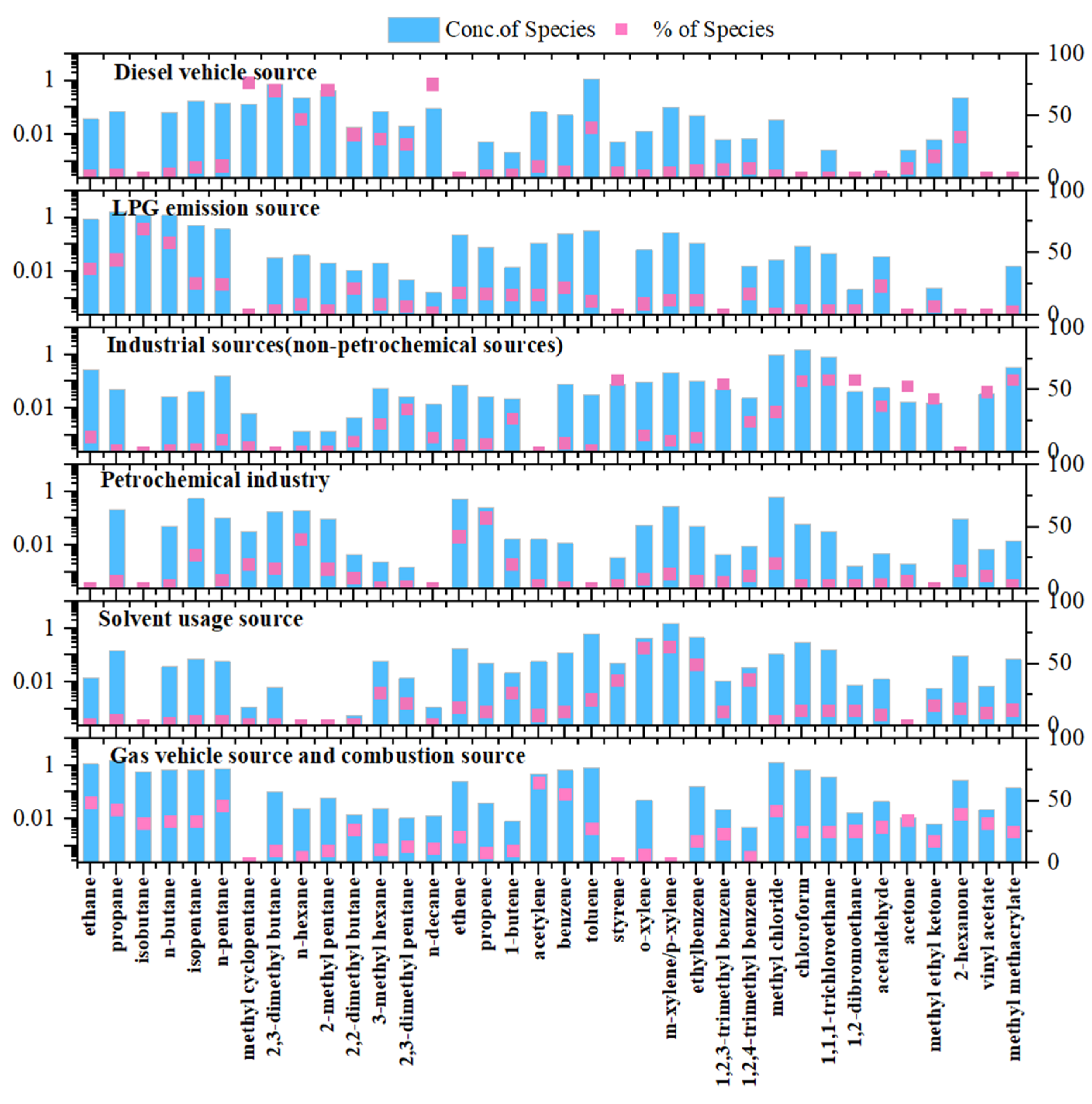

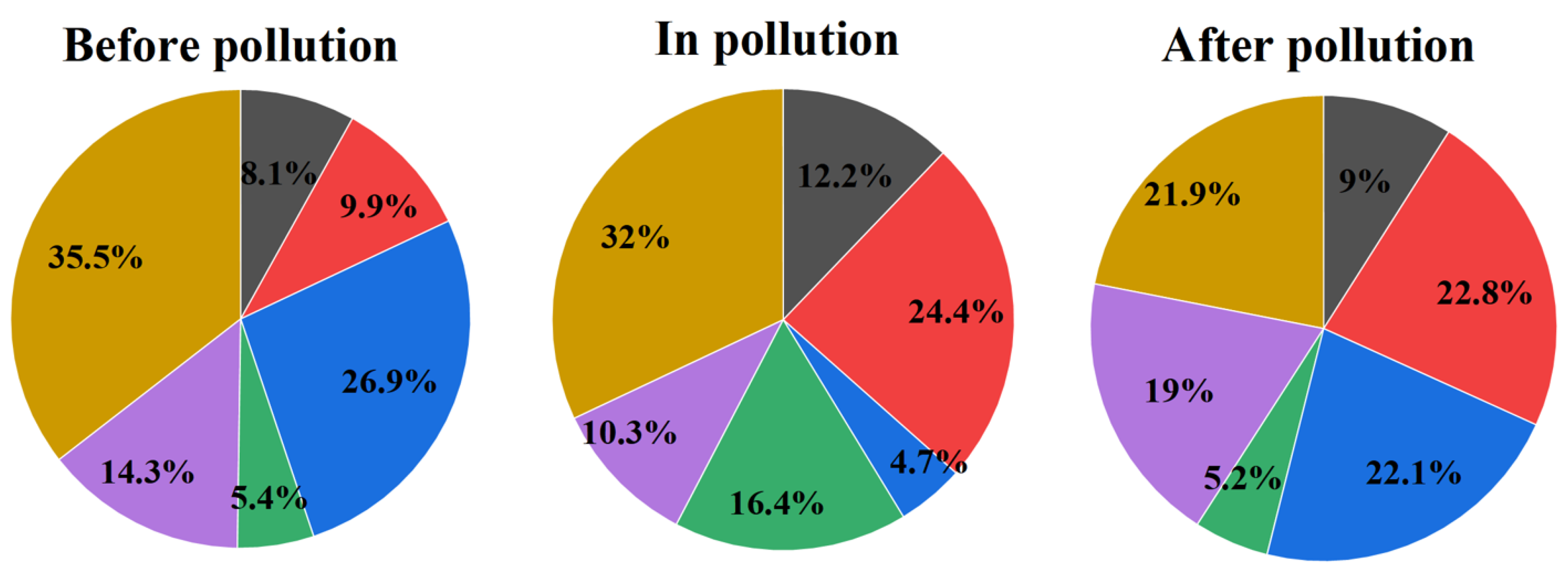
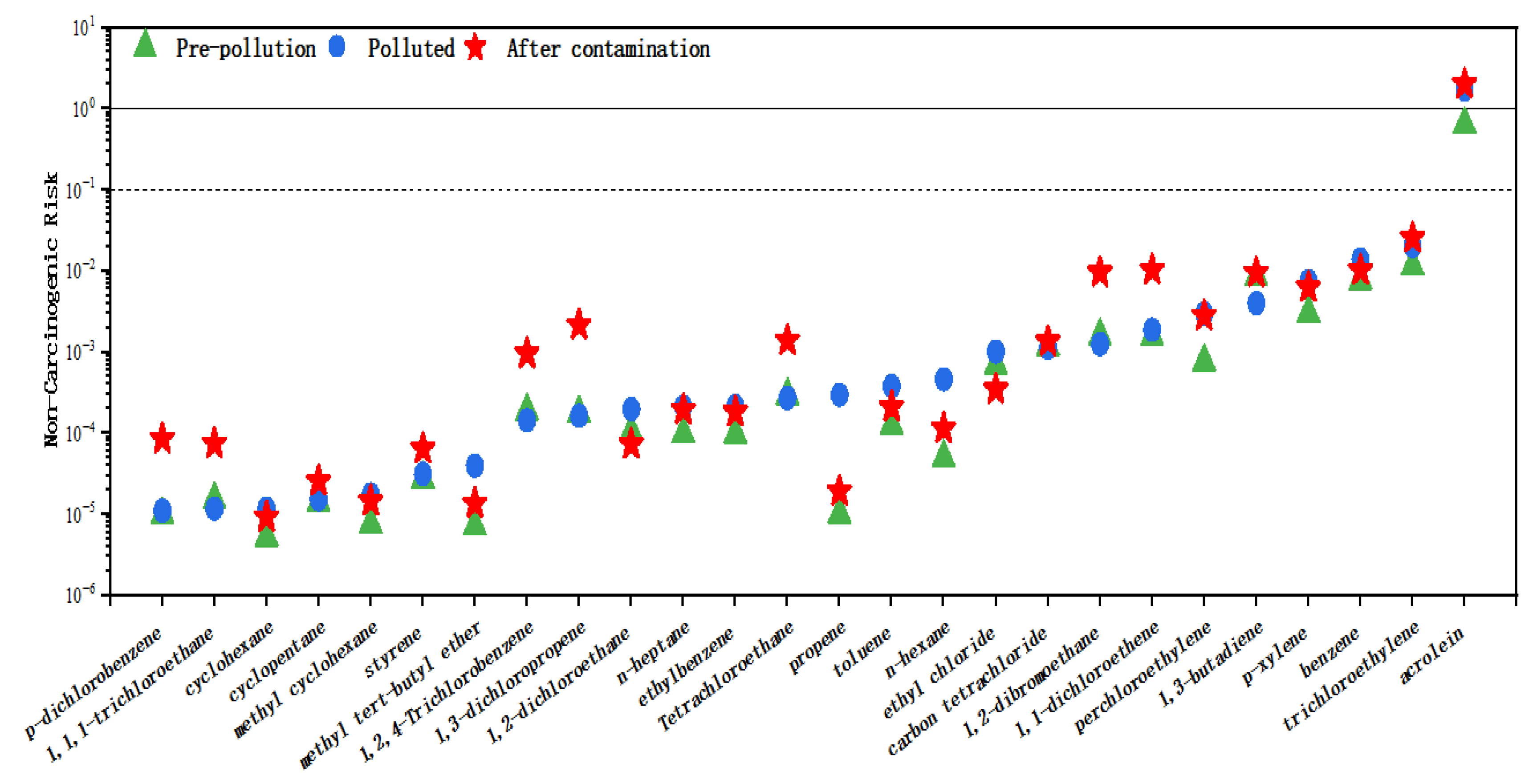

| Stage | Temperature (°C) | Wind Speed (m/s) | Relative Humidity (%) | Precipitation (mm) | ||||||
|---|---|---|---|---|---|---|---|---|---|---|
| Max | Min | Average | Max | Min | Average | Max | Min | Average | Cumulative | |
| Before pollution | 28.8 | 22.0 | 24.7 | 13.1 | 1.4 | 5.4 | 96.5 | 65.2 | 89.4 | 48.0 |
| Polluted | 33.3 | 19.6 | 25.9 | 4.9 | 0.0 | 1.3 | 96.4 | 53.1 | 77.0 | 0.0 |
| After pollution | 29.9 | 19.8 | 25.4 | 4.8 | 0.0 | 2.2 | 96.3 | 43.1 | 69.0 | 0.0 |
| T (°C) | Wdir (deg) | Wspd (m/s) | RH (%) | |
|---|---|---|---|---|
| Mean Obs | 25.34 | 201.76 | 2.96 | 78.61 |
| Mean Sim | 25.54 | 134.32 | 3.51 | 77.15 |
| MBs | −0.20 | 67.45 | −0.55 | 1.46 |
| Gross Error | 3.25 | 108.62 | 1.47 | 6.23 |
| RMSE | 4.17 | / | 1.83 | 8.33 |
| IOA | 0.78 | / | 0.78 | 0.92 |
Disclaimer/Publisher’s Note: The statements, opinions and data contained in all publications are solely those of the individual author(s) and contributor(s) and not of MDPI and/or the editor(s). MDPI and/or the editor(s) disclaim responsibility for any injury to people or property resulting from any ideas, methods, instructions or products referred to in the content. |
© 2025 by the authors. Licensee MDPI, Basel, Switzerland. This article is an open access article distributed under the terms and conditions of the Creative Commons Attribution (CC BY) license (https://creativecommons.org/licenses/by/4.0/).
Share and Cite
Wan, M.; Pang, X.; Yang, X.; Xu, K.; Chen, J.; Zhang, Y.; Wu, J.; Wang, Y. A Case Study of Ozone Pollution in a Typical Yangtze River Delta City During Typhoon: Identifying Precursors, Assessing Health Risks, and Informing Local Governance. Atmosphere 2025, 16, 330. https://doi.org/10.3390/atmos16030330
Wan M, Pang X, Yang X, Xu K, Chen J, Zhang Y, Wu J, Wang Y. A Case Study of Ozone Pollution in a Typical Yangtze River Delta City During Typhoon: Identifying Precursors, Assessing Health Risks, and Informing Local Governance. Atmosphere. 2025; 16(3):330. https://doi.org/10.3390/atmos16030330
Chicago/Turabian StyleWan, Mei, Xinglong Pang, Xiaoxia Yang, Kai Xu, Jianting Chen, Yinglong Zhang, Junyue Wu, and Yushang Wang. 2025. "A Case Study of Ozone Pollution in a Typical Yangtze River Delta City During Typhoon: Identifying Precursors, Assessing Health Risks, and Informing Local Governance" Atmosphere 16, no. 3: 330. https://doi.org/10.3390/atmos16030330
APA StyleWan, M., Pang, X., Yang, X., Xu, K., Chen, J., Zhang, Y., Wu, J., & Wang, Y. (2025). A Case Study of Ozone Pollution in a Typical Yangtze River Delta City During Typhoon: Identifying Precursors, Assessing Health Risks, and Informing Local Governance. Atmosphere, 16(3), 330. https://doi.org/10.3390/atmos16030330






